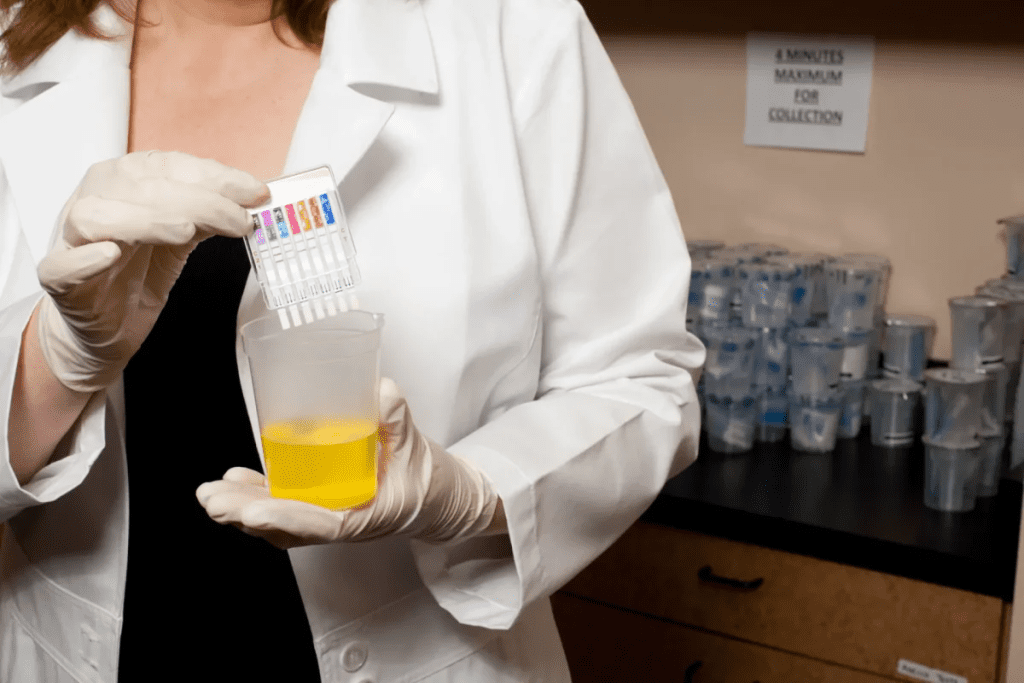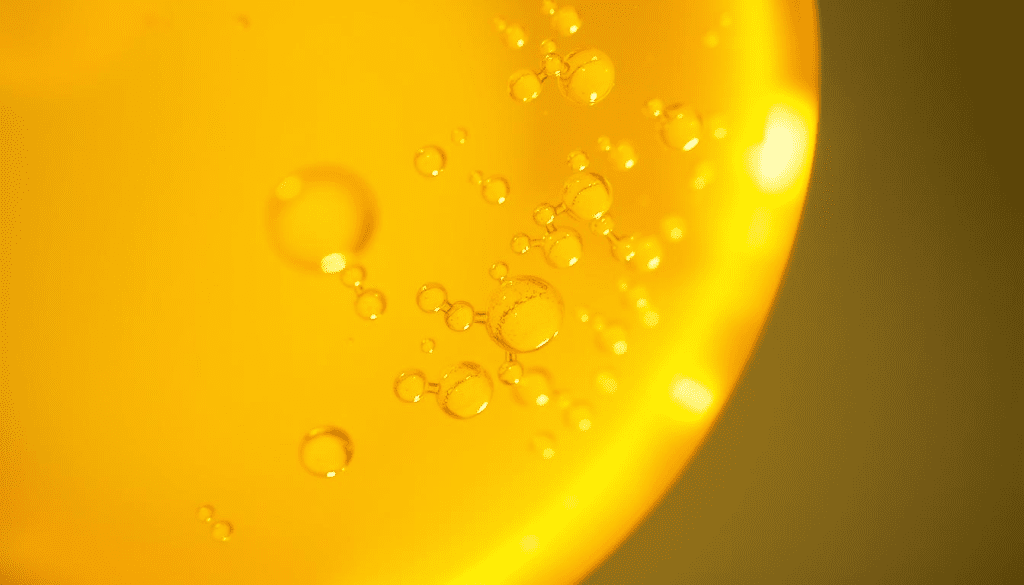Last Updated on November 25, 2025 by
The presence of bilirubin in the urine is a key indicator that a urine test can detect potential liver problems or bile duct issues.
Urine tests can give us important clues about our health, including our liver’s condition. We’ll look into how these tests can show liver issues by finding odd levels of bilirubin and urobilinogen.
The liver’s health is tied to the levels of these substances in our urine. For example, odd bilirubin levels might mean the liver isn’t working right. Studies show urine tests can help spot liver problems. But, how well they work depends on the liver issue being tested.

By understanding urobilinogen’s role in urine and how liver disease changes urine color, we can see urine tests’ value as a diagnostic tool.
The liver and urine are closely linked, giving us clues about liver health. The liver breaks down bilirubin, a yellow pigment from red blood cells. This connection helps us see how urine tests can show liver issues.
The liver turns bilirubin into a form that’s easier to get rid of. This form goes into the bile, which helps digest fats in the intestines. Some of this bilirubin turns into urobilinogen in the intestines and then back into the blood.
The kidneys filter this urobilinogen and put it in the urine. Problems with the liver can change how this process works, showing up in the urine.
For example, if the liver can’t handle bilirubin well, it builds up in the blood and urine. High levels of bilirubin in the urine can mean liver trouble. Changes in urobilinogen levels also hint at liver issues.
One clear sign of liver trouble is darker urine. Normally, urine is light yellow. But if the liver isn’t working right, urine can turn dark yellow or brown. This dark color is often because of bilirubin in the urine.
People might wonder, “why is my pee dark yellow?” when they see this. It could be a sign of liver problems.
Other changes include:
These signs aren’t always clear, but they can lead to checking liver health.

Understanding how the liver, bile, and urine are connected helps doctors use urine tests to check liver health. This shows why looking at urine is key when checking the liver.
Two important markers in urine tests are bilirubin and urobilinogen. They help check liver health and show if there are liver problems.
Elevated bilirubin in urine means liver disease or bile duct blockage. Normally, the liver processes bilirubin and puts it in bile. But, if the liver fails or bile ducts are blocked, bilirubin leaks into urine, making it dark. This is called bilirubinuria and is a first sign of liver trouble.
Key points to consider:
Urobilinogen is a key marker for liver health. It’s made from bilirubin breakdown and is usually in urine in small amounts. Abnormal levels can mean different liver issues. For example, too much urobilinogen might show hemolytic anemia or liver problems, while too little could mean bile duct blockage.
Urobilinogen levels change based on liver function and overall health.
Knowing the normal ranges for bilirubin and urobilinogen in urine is key for diagnosing liver issues. Bilirubin should not be in urine or only in tiny amounts. Urobilinogen levels should be between 0.1 and 1.8 mg/dL (or 1.7 to 30.5 µmol/L).
Levels outside these ranges can be a worry and might show liver problems. For instance, bilirubin over 0.2 mg/dL can mean liver disease. Urobilinogen over 1.8 mg/dL or under 0.1 mg/dL might also show liver issues or other health problems.
Concerning levels:

Urine tests are useful for spotting liver issues, but they’re not always right. We use them first, but knowing their flaws is key for a full diagnosis.
Studies show urine tests are 81-83% accurate for spotting high bilirubin levels. Elevated bilirubin means the liver might not be working right. This can cause jaundice, making skin and eyes turn yellow.
A bilirubin blood test is often paired with urine tests to confirm liver problems. Knowing why bilirubin goes up is important. It can be due to liver disease or blocked bile ducts.
Urine tests are good at finding high bilirubin, but not so much for liver function. They’re only 62-63% accurate for this. This shows urine tests alone might not be enough for liver diagnosis.
The liver does many things, like cleaning toxins and making proteins. So, diagnosing liver issues often needs more than urine tests. Blood tests and imaging are also used.
Urine tests are 47-49% sensitive for liver problems. This means they might miss nearly half of the cases. But, they’re 79-89% specific, meaning most people without liver issues are correctly identified.
Sensitivity is about catching those with the disease. Specificity is about ruling out those without it. Knowing these numbers helps doctors understand test results better.
In short, urine tests are good for a first look at liver problems. But, they have their limits. For a full diagnosis, we need urine tests, blood tests, and other tools together.
Liver conditions can change urine composition, helping doctors diagnose. The liver is key in metabolism and detoxification. It also makes bile, which affects urine color and composition.
Hepatitis is an inflammation of the liver, often caused by viruses or alcohol. It can make urine darker due to more bilirubin. Elevated bilirubin in urine is a sign of liver problems or bile duct blockage.
Urobilinogen levels in urine can also change with hepatitis. Normally, some is present, but in hepatitis, levels may go up or down. This depends on the disease’s stage and severity.
Cirrhosis is a late stage of liver scarring, often from hepatitis or alcohol. It can change urine a lot. Dark urine is common because the liver can’t process bilirubin well.
Urine may also have abnormal substances because of the liver’s poor state. Watching urine changes can help track cirrhosis.
Gallbladder disease, like bile duct blockages, can raise bilirubin levels. This makes urine dark yellow or brown, a sign of jaundice.
Bilirubin in urine can mean there’s a blockage in the bile ducts. This could be from gallstones or other gallbladder issues.
Some medications can harm the liver, changing urine. For example, drugs can raise liver enzymes, altering urine composition.
Checking urine for changes can spot drug-induced liver injury early. Regular urine tests are key for patients on risky medications.
In summary, liver conditions can greatly affect urine, giving doctors important clues. Knowing these changes helps in early detection and treatment of liver diseases.
Urine tests and blood tests are used to check liver health. They work in different ways. Each gives unique information and is used in different situations.
Urine tests are good for first checks because they’re easy and quick. They can spot bilirubin, a sign of liver trouble. This is great for fast checks or when blood tests aren’t possible.
They’re often used at check-ups or for those with liver issues. Their simplicity makes them a top choice for starting assessments.
Blood tests are the best for checking the liver. They look at many liver enzymes and proteins. This gives a detailed view of liver health.
For example, they check ALT and AST levels, which rise with liver damage. Blood tests are more precise and catch early signs of liver problems. They’re key for diagnosing serious issues like hepatitis and cirrhosis.
Urine tests add extra info to liver checks. They work with blood tests to give a clearer picture. For example, they look at urobilinogen levels for liver function insights.
Using both urine and blood tests helps doctors understand liver health better. This approach leads to better monitoring and treatment of liver diseases.
The world of urine testing for liver health is changing fast. New tech is making tests more accurate and easy to use. This helps doctors check liver health better.
Automated urine strip analysis is a big step forward. It has 78.6% agreement rates with old methods. This tech cuts down on mistakes and speeds up results, helping doctors act quickly.
Digital color analysis is another big leap. It makes urine test results more precise. It spots tiny changes in bilirubin levels and urobilinogen in urine, giving deep insights into liver health.
A study on this tech showed it can improve how well tests work. The main benefits are:
At-home liver function tests are becoming more common. But, it’s important to know their limits. They’re handy but might not be as accurate as lab tests. Always talk to a doctor to understand your results.
As we keep improving urine testing tech, it’s key to check reliable sources for updates.
Urine tests are key in checking liver health. They show how well the liver is working by looking at bilirubin and urobilinogen levels. Changes in urine color can also hint at liver problems.
These tests can spot liver issues by finding high bilirubin and odd urobilinogen levels. Even though they’re not perfect, they’re good for first checks or when paired with other tests.
The accuracy of urine tests for liver problems varies. Knowing their strengths and weaknesses helps doctors use them right. This way, they can give better care to patients with liver diseases.
New tech in urine testing, like automated strips and digital color analysis, is making these tests even more useful. By using these tests as part of a bigger diagnostic plan, we can help patients get better care and outcomes.
High bilirubin in urine can mean liver disease, bile duct blockage, or other liver issues. We check bilirubin levels to see how well the liver is working and find any problems.
Urobilinogen is made when bilirubin breaks down in the intestines. If its levels in urine are off, it could mean liver problems like hepatitis or cirrhosis. We look at urobilinogen levels to help figure out and keep an eye on liver health.
Urine tests can hint at liver health, but they’re not always right. Studies show they’re about 81-83% accurate for high bilirubin and 62-63% for liver function. We use them first, but more tests are often needed to be sure.
Dark urine might mean liver issues, as it could have bilirubin. We check why your urine looks off to see if it’s liver disease or something else.
Normally, urine shouldn’t have bilirubin. If it does, it could mean liver disease or bile duct blockage. We check bilirubin levels to see if they’re okay or if more tests are needed.
Yes, some meds can harm the liver and change urine. We watch patients on meds that might hurt the liver and check their liver function, including urine tests, for any problems.
Blood tests are best for checking the liver. But, urine tests can be useful for a first check or to add to blood tests. We use both to fully check liver health.
At-home urine tests can spot liver issues early and are easy. But, it’s key to know their limits and talk to a doctor for the right reading and next steps.
New urine testing tech, like automated strips and digital color analysis, makes tests more accurate and reliable. We use these advances to better diagnose and monitor liver disease.
He, L., Vatsalya, V., Xu, R., Yin, X., Ma, X., Kim, S., Mueller, E. G., Feng, W., McClain, C. J., & Zhang, X. (2025). Urine Metabolites as Biomarkers and Metabolism Mechanism Studies of Alcohol-Associated Liver Disease. International Journal of Translational Medicine, 5(2), 21. https://www.mdpi.com/2673-8937/5/2/21
Subscribe to our e-newsletter to stay informed about the latest innovations in the world of health and exclusive offers!